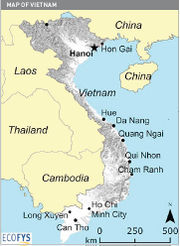Knowledge fuels change
For over a decade, Energypedia has shared free, reliable energy expertise with the world.
We’re now facing a serious funding gap.
Help keep this platform alive — your donation, big or small, truly matters!
Thank you for your support
Vietnam Energy Situation
| Socialist Republic of Vietnam | |||
|---|---|---|---|
| Capital | Hanoi 21°2′N 105°51′E | ||
| Official Languages(s) |
Vietnamese | ||
| Government | Marxist–Leninist single-party state | ||
| President | Trương Tấn Sang | ||
| Prime Minister | Nguyễn Tấn Dũng | ||
| 'Total Area '( km²) | 331,210 | ||
| Population | 90,388,000 (2012 estimate) | ||
| Rural Population | (year) | ||
| GDP (Nominal) | $138.071 billion (2012 estimate) | ||
| GDP Per Capita | $1,527 | ||
| Currency | đồng (VND) | ||
| Time Zone | (UTC+07) | ||
| Electricity Generation | TWh/year (year) | ||
| Calling Code | +84 | ||
| Access to Electricity | |||
| Wind energy (installed capacity) | MW (year) | ||
| Solar Energy (installed capacity) | MW (year) | ||
Overview
Vietnam remains one of world’s fastest growing economies, having sustained an average growth rate of 6.8% over the last seven
years, and currently has a per capita GDP of about £1,100. In spite of these impressive gains, the vast majority of the population continues to live in rural areas where incomes are far below the national average, and is largely dependent on small-scale farming or animal husbandry. In addition, Vietnam is highly vulnerable to adverse impacts of climate change, which may eliminate the much of the gains made in poverty reduction and economic development.
In the last decade, fast industrialization and the economy’s expansion lead to its rapidly growing energy consumption. An increased dependency on fossil fuels is foreseen, and Vietnam is already a net energy importer. Vietnam targets to increase the share of renewable energy in total, commercial, primary energy from 3% in 2010 to 5% in 2020 and 11% by 2050.
Energy Situation Especially in Rural Areas
Energy Demand and Supply in the Household Sector
Rural Electricity Supply
Policy Framework, Laws and Regulations
Poverty Reduction Strategy
Energy Policy
Laws
Institutional Set-up and Actors in the Energy Sector
Public Institutions
Other major activities in the country financed by BMZ or DGIS
Electricity Companies
Power Generation
Transmission
Distribution
Off-grid and Self-supplying Systems
Non Governmental Service Providers for Rural Areas in the Field of Energy
Projects implementing NGOs:
Commercial service provider:
Micro-Finance Institutions:
Key Problems Hampering Access to Modern Energy Services in Rural Areas
Obstacles for grid based rural electrification
Obstacles for off grid energy technologies and services
Further Information
References




















